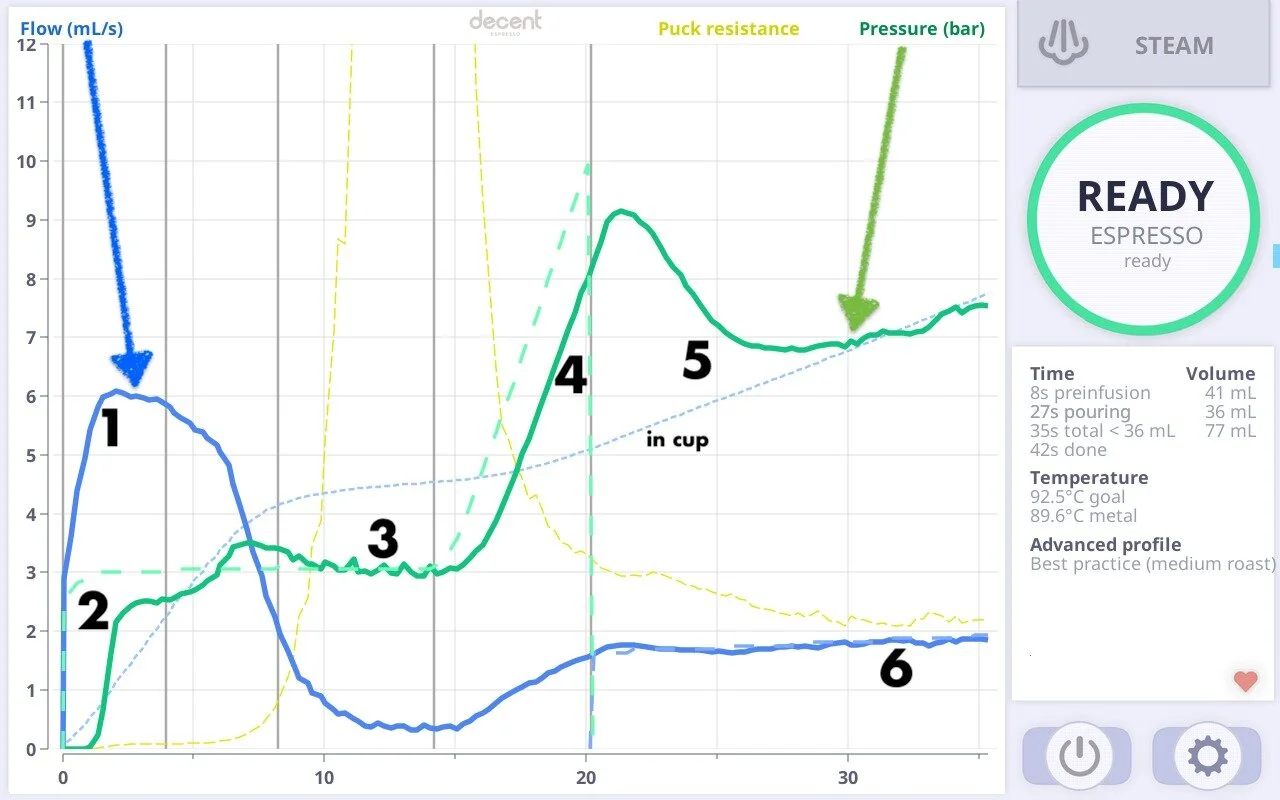Best Practice Espresso Profile
The most impressive, productive (and sometimes over my head) discussion about espresso these days is on the private Decent Diaspora forum. One of the wonderful things about the Decent community, besides its civility, is the way a group of impressively intelligent people collaborate to expand our understanding of espresso extraction.
A recent development has been John’s new “Best Practice” espresso profile. Although it is a work in progress, as all of our profiles are, this development is worth discussing. If you’re not familiar with the Decent’s graphs, bear with me, it’s a lot simpler than it looks at first.
Longtime readers will notice this profile looks a lot like my “Blooming Espresso” profile. The Best Practice Profile includes a few improvements on the Blooming. The improvements come primarily from work by Damian Brakel and Jonathan Gagné.
Quick fill of group head at the start of preinfusion. Preinfusion starts hotter (not shown) than the rest of the shot, to compensate quickly for the cooling effect of the room temperature puck.
Low pressure preinfusion, to assist capillary action in fast, even wetting.
Pressurized bloom to maintain puck integrity. (The low-pressure bloom of the Blooming Espresso can work brilliantly but offers a greater risk of channeling when pressure is reapplied.)
Softened pressure rise to avoid channeling that a steep rise can cause.
Extraction phase switches to flow profiling for automatic channel healing.
Extraction phase has a linear flow-rate ramp over time, to keep constant water contact time, instead of using pressure profiling to approximate this.
Other notes:
The extraction phase uses a pressure limit, so as to never go above the set maximum pressure of 9 bar. This “failsafe” is now a feature many of us for all shots on the DE1, to salvage cup quality if the grind is a little too fine.
The BPP will soon implement Jonathan Gagne’s “adaptive profile” idea, in which the extraction phase will decide the steady-state flow rate relative to flow at peak pressure. This adapts the profile to the grind size, using
Accurate stop-at-volume closely matches scale weight, because of a fully successful preinfusion.
A smooth puck resistance curve is achieved.
While this may be a lot to digest, rest assured that when using the Decent, you can “set it and forget it.” If I were using a DE1 in a cafe, I would use this profile all day, and only adjust the grind as needed. While the Decent’s brain is complex, the user interface couldn’t be simpler.
Some of the "best practices" here were originally discovered on traditional machines:
- Several machines (such as Kees' Idromatic) have a quick fill, followed by a soft-pressure-rise feature built into the group, and manual lever machines have done this for years. (one great thing about the DE1 is it can mimic any feature from any other machine.)
- Pressurized preinfusion is fairly common in traditional machines, but to my knowledge, no traditional machine implements this by measuring puck pressure. Instead they measure pressure-behind-a-flow-constrictor, which gives different results.
To answer the inevitable question, yes, these shots can taste amazing.
I’d love to know your thoughts about this.
*******
Would you like to improve your cupping skills while enjoying delicious coffee? Subscribe to Facsimile and cup along live with Ryan Brown and his guest coffee experts each month. We offer a money-back guarantee, and no commitment is required.


